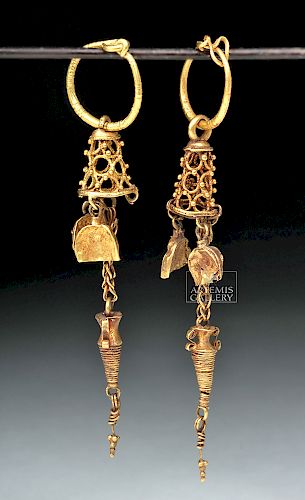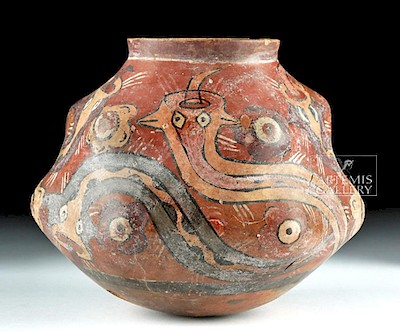Pair Hellenistic Greek 18K Gold Earrings, ex-Christie's
Lot 34
About Seller
Artemis Fine Arts
686 S Taylor Ave, Ste 106
Louisville, CO 80027
United States
Selling antiquities, ancient and ethnographic art online since 1993, Artemis Gallery specializes in Classical Antiquities (Egyptian, Greek, Roman, Near Eastern), Asian, Pre-Columbian, African / Tribal / Oceanographic art. Our extensive inventory includes pottery, stone, metal, wood, glass and textil...Read more
Categories
Estimate:
$3,400 - $5,100
Absentee vs Live bid
Two ways to bid:
- Leave a max absentee bid and the platform will bid on your behalf up to your maximum bid during the live auction.
- Bid live during the auction and your bids will be submitted real-time to the auctioneer.
Bid Increments
| Price | Bid Increment |
|---|---|
| $0 | $25 |
| $300 | $50 |
| $1,000 | $100 |
| $2,000 | $250 |
| $5,000 | $500 |
| $10,000 | $1,000 |
| $20,000 | $2,500 |
| $50,000 | $5,000 |
| $100,000 | $10,000 |
| $200,000 | $20,000 |
About Auction
By Artemis Fine Arts
Jul 5, 2018
Set Reminder
2018-07-05 10:00:00
2018-07-05 10:00:00
America/New_York
Bidsquare
Bidsquare : Ancient | Ethnographic | Fine Art
https://www.bidsquare.com/auctions/artemis-gallery/ancient-ethnographic-fine-art-3306
Featuring classical antiquities, ancient and ethnographic art from cultures encompassing the globe. Artemis Fine Arts info@artemisfinearts.com
Featuring classical antiquities, ancient and ethnographic art from cultures encompassing the globe. Artemis Fine Arts info@artemisfinearts.com
- Lot Description
Greece, Hellenistic Period, ca. late 4th to 1st century BCE. A matched pair of 18 karat gold earrings, each composed of a thin gold loop, a delicate gold cage with granulations on it, and three dangling golden items - two fan-like shapes and one amphora on a chain. The body of each amphora is formed of what looks like a coiled gold wire (probably the result of a stamp), with two wire handles. The delicacy of this work shows the remarkable skill of ancient Greek goldsmiths. The miniature amphora seems to have been a popular motif in Hellenistic Greece, especially in the parts of the Greek Empire that are today the Middle East and Central Asia (for example, some have been found in a burial in southern Tajikistan, which was then part of the Seleucid Empire). The British Museum has a bronze stamp for making amphora-shaped pendants for earrings, giving an idea of how these were made. They also have multiple examples of amphora-shaped earrings - see links for these below. Size of each: 2.45" H (6.2 cm); total weight of both: 4.9 grams
See a few examples of similar earrings at the British Museum: http://britishmuseum.org/research/collection_online/collection_object_details.aspx?objectId=434357&partId=1&searchText=roman+earrings+amphora&page=1; http://britishmuseum.org/research/collection_online/collection_object_details.aspx?objectId=427395&partId=1&searchText=roman+earrings+amphora&page=1
Provenance: private Davis Collection, Houston, Texas, USA; ex-Christie's New York Antiquities Auction, 13 December, 2013, lot 282; ex-Jacques Schulman collection, Amsterdam, The Netherlands, 1974
All items legal to buy/sell under U.S. Statute covering cultural patrimony Code 2600, CHAPTER 14, and are guaranteed to be as described or your money back.
A Certificate of Authenticity will accompany all winning bids.
We ship worldwide and handle all shipping in-house for your convenience.
#132771Slight bending to form of both. Would need to be seen by a professional jeweler to become wearable.Condition
- Shipping Info
-
All shipping is handled in-house for your convenience. Your invoice from Artemis Gallery will include shipping calculation instructions. If in doubt, please inquire BEFORE bidding for estimated shipping costs for individual items.
-
- Buyer's Premium



 EUR
EUR CAD
CAD AUD
AUD GBP
GBP MXN
MXN HKD
HKD CNY
CNY MYR
MYR SEK
SEK SGD
SGD CHF
CHF THB
THB














